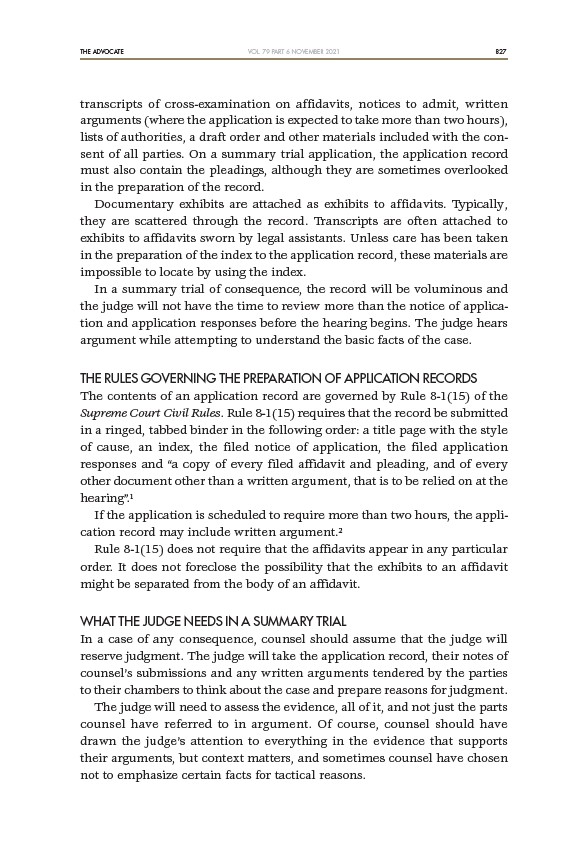
THE ADVOCATE 827
VOL. 79 PART 6 NOVEMBER 2021
transcripts of cross-examination on affidavits, notices to admit, written
arguments (where the application is expected to take more than two hours),
lists of authorities, a draft order and other materials included with the consent
of all parties. On a summary trial application, the application record
must also contain the pleadings, although they are sometimes overlooked
in the preparation of the record.
Documentary exhibits are attached as exhibits to affidavits. Typically,
they are scattered through the record. Transcripts are often attached to
exhibits to affidavits sworn by legal assistants. Unless care has been taken
in the preparation of the index to the application record, these materials are
impossible to locate by using the index.
In a summary trial of consequence, the record will be voluminous and
the judge will not have the time to review more than the notice of application
and application responses before the hearing begins. The judge hears
argument while attempting to understand the basic facts of the case.
THE RULES GOVERNING THE PREPARATION OF APPLICATION RECORDS
The contents of an application record are governed by Rule 8-1(15) of the
Supreme Court Civil Rules. Rule 8-1(15) requires that the record be submitted
in a ringed, tabbed binder in the following order: a title page with the style
of cause, an index, the filed notice of application, the filed application
responses and “a copy of every filed affidavit and pleading, and of every
other document other than a written argument, that is to be relied on at the
hearing”.1
If the application is scheduled to require more than two hours, the application
record may include written argument.2
Rule 8-1(15) does not require that the affidavits appear in any particular
order. It does not foreclose the possibility that the exhibits to an affidavit
might be separated from the body of an affidavit.
WHAT THE JUDGE NEEDS IN A SUMMARY TRIAL
In a case of any consequence, counsel should assume that the judge will
reserve judgment. The judge will take the application record, their notes of
counsel’s submissions and any written arguments tendered by the parties
to their chambers to think about the case and prepare reasons for judgment.
The judge will need to assess the evidence, all of it, and not just the parts
counsel have referred to in argument. Of course, counsel should have
drawn the judge’s attention to everything in the evidence that supports
their arguments, but context matters, and sometimes counsel have chosen
not to emphasize certain facts for tactical reasons.